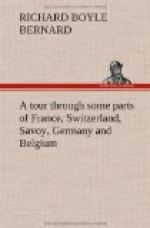Paris, including all its suburbs, is said to be about eight leagues in circumference, and, except London and Constantinople, exceeds all the other cities of Europe in extent.
The markets of Paris are remarkably well supplied with provisions of every description, and at a price which appears moderate to an Englishman. I have been told, that fuel is sometimes at a very high price in the winter; but not being there at that season, I cannot speak from my own experience. What I had most reason to complain of during my stay, was scarcity of that great essential to health and cleanliness, good water. The city is for the most part supplied with this first of necessaries from the river Seine. Adjoining to one of the bridges is a vast machine, which raises its waters, which are conducted to all parts of the town, and also supply several public fountains. They have, however, an extremely bad taste from the numerous establishments for washing for all Paris, which are established in boats on all parts of the river, which is thus strongly impregnated with soap-suds, and its cathartic qualities have been experienced by many strangers on their first arrival in Paris.
The French never drink this water without mixing in it a proportion of sugar, and then call it eau sucre, which is often called for at the coffee-houses. Most houses have reservoirs of sand for filtering the water before it is used for drinking; but those who have been accustomed to the luxury of good water, cannot be soon reconciled to that of the Seine. The water of the Ville d’Arblay is sold in jars in the streets for making tea, and some of the fountains are supplied by springs. I believe the late government had a scheme in contemplation for the construction of an aqueduct, to supply purer water for the Parisians than what they now use.
Many fountains have been established within the last few years, and the site of that once formidable building the Bastile is now occupied by one. None of these modern fountains (although many of them display much taste) are, however, by any means to be compared, in point of elegance, to that which stands in the market of Innocents, and which was erected in the year 1550. Its situation is too confined for so handsome a structure, and I had some difficulty in finding my way to it. It has the following inscription from the pen of M. Santeuil, (who has furnished many others, particularly that on the fountain near the Luxemburg Palace:)
FONTIUM NYMPHIS.
Quos duro cernis simulatos
marmore fructus
Hujus Nympha loci credidit
esse suos.
Which may be thus translated,
The fruits you see on this
cold marble hewn,
This Fountain’s Nymph
believes to be her own.




